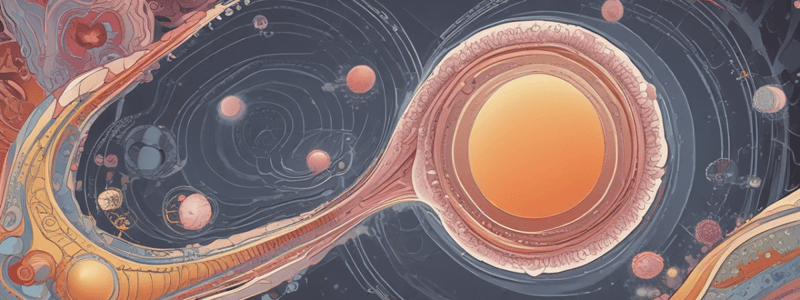Podcast
Questions and Answers
What is the approximate volume of breast milk produced by females per infant?
What is the approximate volume of breast milk produced by females per infant?
- 2 liters
- 1.5 liters (correct)
- 2.5 liters
- 1 liter
What is the term for a gene that will be seen in the phenotype?
What is the term for a gene that will be seen in the phenotype?
- Recessive
- Homozygous
- Dominant (correct)
- Heterozygous
What is the purpose of capacitation in the fertilization process?
What is the purpose of capacitation in the fertilization process?
- To enhance the survival of sperm cells in the acidic environment
- To facilitate the fusion of multiple sperm cells with the oocyte
- To increase the speed of sperm movement
- To enable the sperm's enzymes to penetrate the oocyte (correct)
What is the purpose of a Punnett square?
What is the purpose of a Punnett square?
What is the reason why most genetic disorders are passed down on the recessive gene?
What is the reason why most genetic disorders are passed down on the recessive gene?
What is the primary reason why most sperm cells do not fertilize the oocyte?
What is the primary reason why most sperm cells do not fertilize the oocyte?
What is the result of having only one X chromosome instead of two?
What is the result of having only one X chromosome instead of two?
What happens to the plasma membrane of the oocyte after a sperm cell fertilizes it?
What happens to the plasma membrane of the oocyte after a sperm cell fertilizes it?
What is the exception to the rule that genetic disorders are passed down on the recessive gene?
What is the exception to the rule that genetic disorders are passed down on the recessive gene?
What is the result of the slow block mechanism in fertilization?
What is the result of the slow block mechanism in fertilization?
What is the rarity of identical twins resulting from the fertilization process?
What is the rarity of identical twins resulting from the fertilization process?
What is the final result of the fertilization process?
What is the final result of the fertilization process?
During which stage of gestation does the offspring float toward the uterus?
During which stage of gestation does the offspring float toward the uterus?
What is the function of trophoblasts in the blastocoel?
What is the function of trophoblasts in the blastocoel?
What percentage of conceptuses fail to implant in the uterine wall?
What percentage of conceptuses fail to implant in the uterine wall?
What hormone allows the corpus luteum to survive during pregnancy?
What hormone allows the corpus luteum to survive during pregnancy?
What is the result of implantation in a non-desirable place?
What is the result of implantation in a non-desirable place?
What is the function of the yolk sac?
What is the function of the yolk sac?
During which weeks does the placenta develop?
During which weeks does the placenta develop?
What is the result of lack of folate in the diet during pregnancy?
What is the result of lack of folate in the diet during pregnancy?
During which weeks does sensory organ development begin?
During which weeks does sensory organ development begin?
What is the average weight of a newborn?
What is the average weight of a newborn?
What is the approximate weight gain per month during the first trimester?
What is the approximate weight gain per month during the first trimester?
Why does morning sickness occur during pregnancy?
Why does morning sickness occur during pregnancy?
What is the primary reason for the decrease in blood flow during pregnancy?
What is the primary reason for the decrease in blood flow during pregnancy?
What is the main reason for the oxygen demand increase during pregnancy?
What is the main reason for the oxygen demand increase during pregnancy?
What is the role of Montgomery glands during breastfeeding?
What is the role of Montgomery glands during breastfeeding?
What is the duration of the postpartum period?
What is the duration of the postpartum period?
What is the term for the uterus returning to its original size?
What is the term for the uterus returning to its original size?
What is the primary reason for the baby's difficulty in controlling body temperature?
What is the primary reason for the baby's difficulty in controlling body temperature?
What is the purpose of the APGAR score?
What is the purpose of the APGAR score?
What is the composition of breast milk for days 3-10 postpartum?
What is the composition of breast milk for days 3-10 postpartum?
Flashcards are hidden until you start studying




